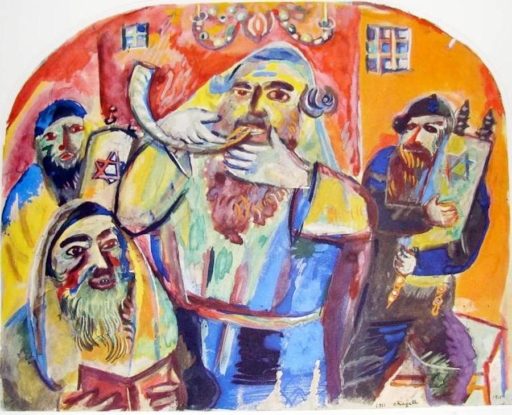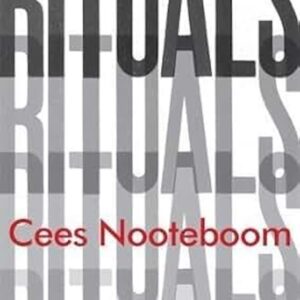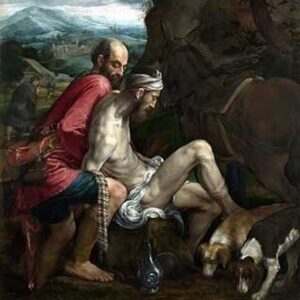As I write this, it is Erev Rosh Hashanah here in Michigan. In a few hours the sun will set, the Jewish month of Elul—the month of teshuvah, turning back to Hashem and his Law—will end and with it the 5,781st year from creation, according to the mythological reckoning. The season of repentance deepens through the ten Days of Awe with which Judaism begins the new year, the time from Rosh Hashanah through Yom Kippur, the Day of Atonement.
Fittingly for this time of turning and returning, the weather here has shifted over the past week: another summer of unusually scorching and violent weather has given way to mild, clear air. Much of the summer was terribly humid, more like the climate I grew up with in the Ohio Valley than what belongs properly to the Great Lakes, and on many days the sky was a sallow haze—or to speak more accurately, a pall cast by the incinerating forests of western North America. Today, though, the sky has been in most directions a crystalline blue. I might say it has been tekhelet, the holiest color of Jewish tradition, an aid to prayer.
I have before me a book whose color is predominantly something like tekhelet, Shmuel Yosef Agnon’s Days of Awe. Agnon was of my great-grandparents’ generation (he lived from 1888-1970) and of their place, what was at the time of his birth called Galicia in the Austro-Hungarian Empire. Agnon’s upbringing was traditional and religious, also somewhat secular and modern. He went on to live in Germany and Mandate Palestine (later to become the state of Israel), and to write some of the most important fiction yet to appear in modern Hebrew. To me, in terms of craft, Agnon has been particularly valuable for his supple conception of the narrator.
But Agnon’s Days of Awe is not fiction, though it is a pastiche of different kinds of narrative in the manner of the Talmud. What is it, then? Despite having read Agnon’s Days of Awe around Rosh Hashanah every year for the past five years, it’s hard for me to say. It’s like a machzor, the prayerbook for the High Holy Days, if a prayer book were an anthology of…fiction. Perhaps instead of fiction I should write something like mythical, religious, and legal lore. But I like to use fiction, because I think that what defines fiction is not facticity or its lack, but the presence of a narrator or storyteller. No one but Agnon, master of fiction, could have written Days of Awe.
To be clear: I read this book every year as an act of religious devotion. The feelings that my reading occasions in me are the truest feelings of belief and repentance of which I’m capable, certainly as true as anything the Christian portion of my cultural heritage gives me. But I also perceive something else, an artistry not finally separable from devotion. That combination makes some people uneasy: they seem to feel that artistry precludes sincere religious faith, or vice versa. I’m not talking about puritanical philistines. The people I mean were the kind surprised to see Agnon wearing a yarmulke when he accepted the Nobel Prize in 1966. Surely such a master of sophisticated, subtle, ironic narration could not believe in a story infinitely greater than one of his own invention?
I think that for Agnon, art and faith and doubt (which, let us not forget, is a form of faith) were of a piece. And I have come to think that it is precisely the artistry of Agnon’s Days of Awe which causes the work to quicken my own religious feelings. What Agnon did was to blend an astonishing array of Jewish sources from many times and places within a single, subtle, but all-controlling narrative voice. This is a technique available only to fiction and to poetry (one thinks of modernist poems like Eliot’s and Pound’s).
Here is the very first paragraph, from “the argument of the work.” This is a single sentence, and it accomplishes one of the most pronounced shifts in register I have seen in a single sentence:
For the benefit of those who wish to be informed in the matters of Rosh ha-Shannah and Yom Kippur and the Days Between, I have assembled some sayings from the Torah and from the Prophets and from the Writings, from the Talmud Babylonian and Palestinian, from the halakhic Midrash and the aggadic Midrash, and from the Zohar and from other books written by our Early Rabbis and Latter Rabbis, of blessed memory; and I have arranged all these sayings in three books, according to the order of each of the periods, each period and its matter.
Through “I have assembled” we have the voice of a modern scholar, and in English it almost sounds pedantic (this is not so in the Hebrew or in Jewish culture generally, I would say). But then we move into a pious rather than scholarly enumeration of sources (to the extent that distinction holds in Jewish culture), and end with a clear imitation of biblical style. And yet throughout there is the narrator, the I. Why not call this Agnon himself? Here is how a paragraph begins in the first part of the book, which deals with Rosh Hashanah:
I heard Rabbi Hayyim of Volozhin [18th-19th cent.] speak in amazement at the popular custom of addressing the prayer, “Bless me for peace,” to the angels on Sabbath eve….
That is just how the text looks in the English edition: I have only added the bolded emphasis. The paragraph appears in a subsection headed “Ye who usher in compassion,” which is the title of a liturgical poem. If it weren’t for the editorial intervention in brackets, you would feel the narrator was speaking to you from two centuries back.
In the final section, treating Yom Kippur, under the heading “Reminiscence: an American farmer” I find the following passage, with which I’ll end. This comes from an immigrant who left America in the early twentieth century because he and his family found it even harder to be Jewish farmers here than in Imperial Russia. But I only know this from following the notes. The text of Days of Awe is unified in the way that fiction is unified, even if it contains a chorus of voices: by the narrator—not Agnon—in this case the voice of Every Jew, who has traveled up and down the centuries listening to the teachers and sages and common folk.
I will never forget the beautiful scene that took place during Kol Nidre. The quorum assembled in the house of one of the farmers.… I remembered the Kol Nidre that my forefathers had chanted hiding in dark cellars in Spain.… I seemed to awake from a terrible dream. I saw a beautiful world lying before me. The birds under the window were assisting the cantor with their song, and the heaven and the earth, those witnesses of all that had happened to the people of Israel, were joining in song.
Oh Creator, thou are eternal, and thy folk Israel is eternal.
Jonathan Geltner lives in Ann Arbor MI with his wife and two sons. His translation of Paul Claudel’s Five Great Odes is available from Angelico Press and a novel, Absolute Music, is forthcoming from Slant. He writes more about the meeting of fantasy and fiction with theology, philosophy, music and the sense of place at betweentwomaps.com





